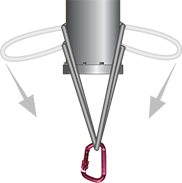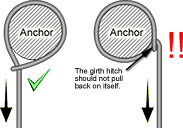The previous page contained an overview of anchors. This page discusses various types of anchors.
Single-point anchors are probably the most common type of anchor. They only require a single strong anchoring point and can be tied quickly.
 Commercial
anchor
straps are manufactured with D-Rings pre-sewn into both ends. They are popular in urban and
industrial rescue because they can be attached quickly without tying a knot. The single-purpose
use of anchor straps make them less popular in backcountry rescue.
Commercial
anchor
straps are manufactured with D-Rings pre-sewn into both ends. They are popular in urban and
industrial rescue because they can be attached quickly without tying a knot. The single-purpose
use of anchor straps make them less popular in backcountry rescue.
 A
single loop of webbing, or cord, is also a popular anchoring technique. The loop is typically
creating by tying a water knot when using webbing or a bowline
when using cord.
A
single loop of webbing, or cord, is also a popular anchoring technique. The loop is typically
creating by tying a water knot when using webbing or a bowline
when using cord.
The advantages of single-loop anchors are they can be created from standard materials (i.e., cord or webbing) and they require less material than most single-point anchors (e.g., a basket or girth hitch). A disadvantage of single loop anchors is that, unlike wrap-3-pull-2 and girth hitch anchors, they don't cinch onto the anchor and might slide up or down. Another small disadvantage is the knot must be tied after the rope is wrapped around the object.
 Wrap-3-pull-2
anchors (and wrap-2-pull-1 anchors) are created by wrapping rope or webbing around an object multiple
times and then connecting a carabiner to all but one of the strands of rope.
Wrap-3-pull-2
anchors (and wrap-2-pull-1 anchors) are created by wrapping rope or webbing around an object multiple
times and then connecting a carabiner to all but one of the strands of rope.
Most rescuers place the knot against the anchored object, the concept being that by positioning the knot against the anchored object the stresses on the knot will be reduced due to the object's friction. It's a good theory, but in reality the weakest point will be where the carabiner connects to the rope. If you think the knot is creating a safety hazard, you should find another way to strength the anchor.
 A
basket
hitch is created by wrapping a pre-tied (or sewn) loop around an object. Advantages of basket
hitch anchors are they can be created from standard materials, they can be pre-tied and attached
to an object quickly, and, because they have four strands, they are especially strong.
Basket hitch anchors have three potential disadvantages. The first and most important is
that, depending on the length of the loop and the diameter of the anchor the hitch is tied
around, it is possible to
triaxially load the carabiner. Also, as with single loop anchors, basket hitch anchors
don't cinch onto the anchor and might slide up or down the anchor. And although almost
always a non-issue, basket hitch anchors do require a little more material (e.g., webbing)
to create.
A
basket
hitch is created by wrapping a pre-tied (or sewn) loop around an object. Advantages of basket
hitch anchors are they can be created from standard materials, they can be pre-tied and attached
to an object quickly, and, because they have four strands, they are especially strong.
Basket hitch anchors have three potential disadvantages. The first and most important is
that, depending on the length of the loop and the diameter of the anchor the hitch is tied
around, it is possible to
triaxially load the carabiner. Also, as with single loop anchors, basket hitch anchors
don't cinch onto the anchor and might slide up or down the anchor. And although almost
always a non-issue, basket hitch anchors do require a little more material (e.g., webbing)
to create.
 A
girth hitch anchor is created by
wrapping a pre-tied (or sewn) loop around an object and then passing one end of the loop through the other
end—creating a girth hitch around the object.
A
girth hitch anchor is created by
wrapping a pre-tied (or sewn) loop around an object and then passing one end of the loop through the other
end—creating a girth hitch around the object.
As with basket hitch anchors, girth hitch anchors can be pre-tied using standard materials and assembled quickly. A disadvantage of girth hitch anchors is that if they are positioned incorrectly on the object (see illustration), they can create 2:1 leverage on the "hitch" which could cause the nylon-on-nylon to fail. This is easy to resolve with proper positioning, but it must be consciously recognized by the rescuers.